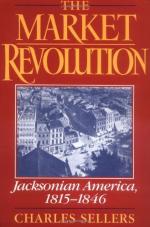
|
Chapter 1, Land and Market
• The period from 1812 to 1837 saw a fundamental change in American culture.
• This change evolved from the conflict between land and market, in which landowners and labor were in equilibrium.
• As land became cheaper and labor became cheaper, the structure of society changed to be more democratic and more capitalistic.
Chapter 2, Ambiguous Republicanism
• Thomas Jefferson came to power through an anti-commercial, anti-capitalist landowner groundswell.
• Thomas Jefferson's anti-market stance was weakened by James Madison, who was more market-oriented.
• New York in particular became powerful as capitalism developed.
Chapter 3,
• The Republican forces consolidated their power through the National Bank.
• Henry Clay and John Calhoun were key players in expanding American commerce and power.
• The federal government asserted its power over the states and also used its force to relocate the Native Americans.
Chapter 4, The Crisis of 1819
• As the Republican party created a wealthy and corrupt elite society...
|
This section contains 540 words (approx. 2 pages at 300 words per page) |

|




